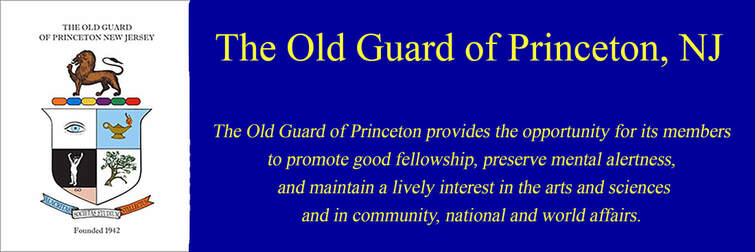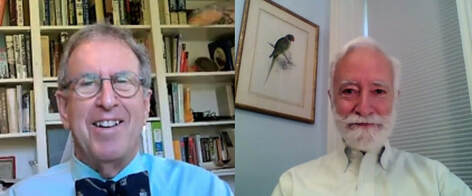October 20, 2021
The Natural History of Edward Lear
Robert Peck
Author, naturalist, historian, and senior fellow of the Academy of Natural Sciences,
Drexel University
Minutes of the Seventh Meeting of the 80th Year
The meeting took place on Zoom, with Stephen Schreiber presiding.
Minutes of the previous week’s meeting were read by Bernie Miller. Guests included Jim Merritt and Will Howarth, introduced by Lanny Jones; Alexandra Radbil and Deborah Macmillan, introduced by Welmoet van Kammen; Florence Kahn, introduced by Ruth Miller; and Scott Magargee, introduced by Al. One hundred thirty-one members were in attendance.
The Natural History of Edward Lear was the title not only of Robert Peck’s talk but also the title of a book by Peck, on which he based his talk. Devoting most of his time to Lear’s life and work, our speaker concluded by mentioning some of the artists and illustrators who have been influenced by Lear over the years, including Beatrix Potter and Maurice Sendak.
Edward Lear, born in 1812, was the 20th child in a family of 21. Their mother was certainly prolific, and one might say that Lear took after her, though in an utterly different sphere. In fact, Lear himself never married, but as a naturalist, artist, humorist, cartoonist, and poet, he was indeed extremely prolific. Best known today for his limericks and nonsense rhymes, such as “The Owl and the Pussy Cat,” Lear had indeed feared that his reputation as a scientist would be overshadowed by his appeal as a humorist. His fears were borne out when, in 1988, the Royal Mail printed four stamps marking the centenary of Lear’s death, with each stamp imprinting an illustration of one of his poems or limericks. Despite his cartoonish illustrations to his own poems, Lear saw himself as a serious artist and scientist, one who studied wildlife, especially birds, painting them accurately, and exquisitely, from life.
Lear’s earliest instructor as an artist was his older sister Ann (who had raised him), and together they produced an album of paintings of birds and botanical specimens during the years 1827 to 1830, when Lear was a precocious teenager. It is quite difficult in fact to distinguish between the paintings done by Ann and those done by Edward.
The London Zoo seems to have been one of Lear’s childhood haunts, and his first self-publishing venture was “Sketches of Animals Zoological,” which appeared when he was still a teenager. By 1829, though, he had abandoned the venture, perhaps because a more lucrative source of income had caught his attention. Parrots had become a popular pet among the aristocracy, and Lear embarked on the creation of a book of meticulously drawn parrots, hoping to cash in on their popularity. Perhaps it was this very book that attracted the attention of Queen Victoria, who took ten lessons from Lear as her drawing instructor.
Edward Lear’s early mentor, John Gould, was unfortunately also something of a competitor, and the relationship was rather fraught in consequence. Lear felt himself exploited on occasion, as Gould did not always credit him for his work.
Among Lear’s many patrons, though, by far the most important and generous was Edward Stanley, the 13th Earl of Derby, one of the wealthiest men in England, and president of the Zoological Society. Stanley had a huge collection of birds and animals at his estate, Knowsley Hall, and he also had lots of children. Lear was invited there several times and became, for a while, almost part of the family. It was the ideal environment for him, as the children complemented Lear’s own sense of fun and mischief; it may have been for the Stanley children that Lear composed and illustrated his ever popular “The Owl and the Pussycat.”
In 1835, Lear asked Lord Derby if he would approach John J. Audubon to see if Lear might accompany him on one of his trips to North America. Audubon refused and neither man ever mentioned the matter again, though their mutual respect remained intact. Audubon, for example, purchased a copy of Lear’s parrot book.
From 1837 on, Lear indulged his passion for travel, visiting Egypt, Ceylon, and India, painting as he went. He made his home in Italy, and at the time of his death he was living in San Remo. The modest, self-effacing Edward Lear is buried in Poets’ Corner at Westminster Abbey.
Lear left 7,000 watercolors, 2,000 studio watercolors, 300 oil paintings and more than 200 lithographs. He was indeed prolific.
In closing, Robert Peck mentioned not only children’s illustrators inspired by Lear, but also contemporary artists influenced by him, such as the Australian William Cooper, famous for his illustrations of birds; and James Prosek, whose 2011 painting titled “Cockatool” shows a similarly whimsical streak to Lear’s own.
Respectfully submitted,
Joan Fleming
Minutes of the previous week’s meeting were read by Bernie Miller. Guests included Jim Merritt and Will Howarth, introduced by Lanny Jones; Alexandra Radbil and Deborah Macmillan, introduced by Welmoet van Kammen; Florence Kahn, introduced by Ruth Miller; and Scott Magargee, introduced by Al. One hundred thirty-one members were in attendance.
The Natural History of Edward Lear was the title not only of Robert Peck’s talk but also the title of a book by Peck, on which he based his talk. Devoting most of his time to Lear’s life and work, our speaker concluded by mentioning some of the artists and illustrators who have been influenced by Lear over the years, including Beatrix Potter and Maurice Sendak.
Edward Lear, born in 1812, was the 20th child in a family of 21. Their mother was certainly prolific, and one might say that Lear took after her, though in an utterly different sphere. In fact, Lear himself never married, but as a naturalist, artist, humorist, cartoonist, and poet, he was indeed extremely prolific. Best known today for his limericks and nonsense rhymes, such as “The Owl and the Pussy Cat,” Lear had indeed feared that his reputation as a scientist would be overshadowed by his appeal as a humorist. His fears were borne out when, in 1988, the Royal Mail printed four stamps marking the centenary of Lear’s death, with each stamp imprinting an illustration of one of his poems or limericks. Despite his cartoonish illustrations to his own poems, Lear saw himself as a serious artist and scientist, one who studied wildlife, especially birds, painting them accurately, and exquisitely, from life.
Lear’s earliest instructor as an artist was his older sister Ann (who had raised him), and together they produced an album of paintings of birds and botanical specimens during the years 1827 to 1830, when Lear was a precocious teenager. It is quite difficult in fact to distinguish between the paintings done by Ann and those done by Edward.
The London Zoo seems to have been one of Lear’s childhood haunts, and his first self-publishing venture was “Sketches of Animals Zoological,” which appeared when he was still a teenager. By 1829, though, he had abandoned the venture, perhaps because a more lucrative source of income had caught his attention. Parrots had become a popular pet among the aristocracy, and Lear embarked on the creation of a book of meticulously drawn parrots, hoping to cash in on their popularity. Perhaps it was this very book that attracted the attention of Queen Victoria, who took ten lessons from Lear as her drawing instructor.
Edward Lear’s early mentor, John Gould, was unfortunately also something of a competitor, and the relationship was rather fraught in consequence. Lear felt himself exploited on occasion, as Gould did not always credit him for his work.
Among Lear’s many patrons, though, by far the most important and generous was Edward Stanley, the 13th Earl of Derby, one of the wealthiest men in England, and president of the Zoological Society. Stanley had a huge collection of birds and animals at his estate, Knowsley Hall, and he also had lots of children. Lear was invited there several times and became, for a while, almost part of the family. It was the ideal environment for him, as the children complemented Lear’s own sense of fun and mischief; it may have been for the Stanley children that Lear composed and illustrated his ever popular “The Owl and the Pussycat.”
In 1835, Lear asked Lord Derby if he would approach John J. Audubon to see if Lear might accompany him on one of his trips to North America. Audubon refused and neither man ever mentioned the matter again, though their mutual respect remained intact. Audubon, for example, purchased a copy of Lear’s parrot book.
From 1837 on, Lear indulged his passion for travel, visiting Egypt, Ceylon, and India, painting as he went. He made his home in Italy, and at the time of his death he was living in San Remo. The modest, self-effacing Edward Lear is buried in Poets’ Corner at Westminster Abbey.
Lear left 7,000 watercolors, 2,000 studio watercolors, 300 oil paintings and more than 200 lithographs. He was indeed prolific.
In closing, Robert Peck mentioned not only children’s illustrators inspired by Lear, but also contemporary artists influenced by him, such as the Australian William Cooper, famous for his illustrations of birds; and James Prosek, whose 2011 painting titled “Cockatool” shows a similarly whimsical streak to Lear’s own.
Respectfully submitted,
Joan Fleming

